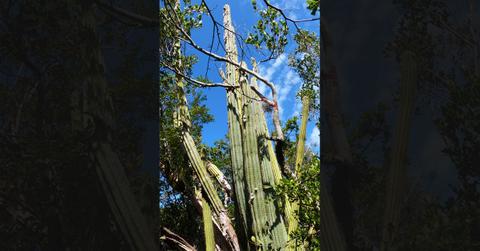Researchers Declare First Extinction of Species in United States Connected with Rising Seas

The Key Largo tree cactus can grow to impressive heights.
Researchers say the disappearance of the Key Largo tree cactus may be the first local extinction of a species in the U.S. caused by rising sea levels.
The Key Largo tree cactus (Pilosocereus millspaughii) was found in just a single population in the U.S., in the Florida Keys, in 1992, though it still grows in a few areas in the Caribbean, including parts of Cuba and The Bahamas.
The Florida Keys population dwindled from a "thriving stand of about 150 stems," to just six "ailing fragments" in 2021, which researchers removed for off-site cultivation to ensure their survival. The Key Largo tree cacti in the U.S. fell victim to salt water intrusion from rising sea levels, soil erosion from hurricanes and tides, and being eaten by mammals, according to researchers.
“Unfortunately, the Key Largo tree cactus may be a bellwether for how other low-lying coastal plants will respond to climate change,” Jennifer Possley, director of regional conservation at Fairchild Tropical Botanic Garden and lead author on a study published recently in the Journal of the Botanical Research Institute of Texas, said in a statement.
When researchers first found the species in an isolated mangrove forest, they thought it was the similar Key tree cactus (Pilosocereus robinii), a federally endangered species found in the Florida Keys. The two species appear similar, with stems that can grow more than 20 feet tall, cream-colored flowers that "smell like garlic and reflect moonlight, attracting bat pollinators," and brightly colored fruits that attract birds and mammals.
“The most striking difference is the tuft of long, woolly hairs at the base of the flowers and fruits,” said Alan Franck, currently the herbarium collection manager at the Florida Museum of Natural History, who suspected the Key Largo tree cactus was a different species. Franck confirmed in 2019 that the Key Largo population was the only one known in the U.S.
Researchers at Fairchild began monitoring all of the tree cactus populations annually in 2007. They learned that salt levels were higher in the soil under dead cacti compared to living cacti in the years following a major storm surge in the Lower Keys, pinpointing salinity as a factor in their decline.
Samples collected for controlled cultivation are now growing in pots at a facility in Coral Gables, Fla., and seeds from both wild and cultivated cacti are banked for conservation.
- What Lies Beneath: NASA Scientist Believes Aliens May Have Found 'Perfect' Hiding Spot in Earth's Oceans
- Global Threat: Russia Insider Warns West of 'World War Using Nuclear Weapons' Amid Escalating Support for Ukraine
- Countdown to Disaster? Ex-NATO Official Warns Russia, Iran and China Could Wage WWIII in Just Years
The Key Largo tree cactus was growing on a limestone outcrop surrounded by mangroves, but the layer of soil has been stripped away over the years by hurricane storm surges and high tides. Now the area is being overtaken by salt-tolerant plants that were previously restricted to the brackish water under the mangroves.
“In 2011, we started seeing saltwater flooding from king tides in the area,” said study co-author James Lange, a research botanist at Fairchild, referring to particularly high ocean tides. “That limits the amount of freshwater available to small mammals and might be related to why the herbivores targeted this cactus, but we can’t say for sure. We’d never seen cactus herbivory like this anywhere in the Lower Keys, where flooding has tended to be less extensive.” Cacti store water in their stems, allowing them to survive droughts.
Then, in 2015, Lange and his colleagues found that half the cacti had died, due to an "alarming amount" of herbivory, or being eaten. The next year, another 50% had died.
Never miss a story — sign up for the Front Page Detectives newsletter. Be on the scene the moment news breaks.
In 2017, category 5 Hurricane Irma brought a 5-foot storm surge, flooding large portions of Key Largo for several days. In 2019, king tides flooded large portions of the island, including the tree cactus habitat, for three months.
In 2021, all the remaining Key Largo tree cactus material was replanted in controlled settings.
“We have tentative plans with the Florida Department of Environmental Protection to replant some in the wild,” Possley said. A similar endeavor has already been undertaken for the similar Key tree cactus.
“The amount of reintroduced material of this species is already more than the amount of wild material that’s left,” Possley said of the Key tree cactus. But suitable habitats for reintroduction are disappearing.
“It’s generally a fringe between the mangroves and upland hammocks called thorn scrub, and there just aren’t many places like that left where we can put reintroduced populations," Possley said.
“We are on the front lines of biodiversity loss,” said study co-author George Gann, executive director for the Institute for Regional Conservation. “Our research in South Florida over the past 25 years shows that more than one-in-four native plant species are critically threatened with regional extinction or are already extirpated due to habitat loss, over collecting, invasive species and other drivers of degradation. More than 50 are already gone, including four global extinctions.”
TMX contributed to this report.
Become a Front Page Detective
Sign up to receive breaking
Front Page Detectives
news and exclusive investigations.
